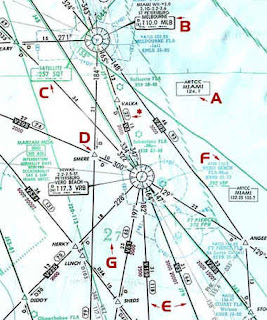Monday: We started with our block 3 exam, which was based on all the materials from last week (Charts, FARs, and Navigation). I scored 100% on the exam, and I was the only one to do so.
We covered two non-weather units today, the first of which was "Introduction to Emergencies." This lesson is literally as easy as it sounds. For example, what do you call it when an aircraft has a situation that requires immediate attention/assistance due to a situation on board? Aircraft in Distress. There was more to it than just the simple definitions, but this was one of our easier lessons.
The second lesson of the day was "Search and Rescue," which required a little more attention, only because the rules vary depending on the type of flight plan. The national search and rescue plan pools the resources of several different agencies, and we needed to learn how each agency contributes towards search and rescue of missing aircraft.
We finished both lessons early, and since we can't technically start weather until the weather service teacher got there, we spent the afternoon reviewing our first 3 blocks (At this point, we are less than 10 days away from the cumulative final, so we wanted to review stuff from the first couple weeks of class).
Tuesday-Friday: Welcome to the slowest days of class EVER. For every basics class, they have a teacher from the National Weather Service (Norman, OK) come teach us 3.5 days of weather fundamentals. Our teacher was an extremely knowledgeable and frinedly gentleman, however, he was the most boring teacher that we've had to date. Every day during weather, there were several people who dozed off at one point or another, and our Contract instructors seemed to even expect this lol. It was bad, however, at the end, we did learn quite a bit about weather.
The first unit was the fundamentals of weather (how the atmosphere works, winds, clouds etc.). Next we studied weather hazards (Thunderstorms, fog, IFR conditions, snow, volcanic ash etc.). The next 3 units were all aviation related: METARS, TAFs, FAs, Winds Aloft, SIGMETS, AIRMETS, Convective SIGMETS, CWAs, MISs,PIREPs and more!!! I'll cover a few of the basics.
METAR: this tells the current conditions at a weather observation facility. We had to learn how to decode the METARs, and also learn how to properly phrase them when required. For example, here is the current METAR for BWI:
METAR KBWI 122254Z 18004KT 10SM BKN200 02/M12 A3054 RMK AO2 SLP344 T00221122
What does it all mean?? Well, here is how I would read that to you as an ATC:
Baltimore, two-two-five-four observation: Wind one-eight-zero at four, visability one-zero, ceiling two-zero thousand broken, temperature two, dew point minus one-two, altimeter three-zero-five-four. Remarks: Sea Level pressure One zero three four point four.
Sounds like fun, right? :) SURE.
There are other weather reports that forecast the conditions within the next 24 hours, within 5 miles of an airport, and they are called TAFs or Terminal Aerodrome Forecasts. Here's an example of the current TAF for BWI:
KBWI 122328Z 1300/1406 18004KT P6SM BKN200Who wants to try to translate? Basically, any time a significant change is forecasted within an hour, the next change is issued in a 'from' or FM statement. For example, if you look at the difference between the third and fourth line, the fourth line reads: From 1pm on the 13th day, wind 140 at 5 knots, visibility 4 statute miles, Light Rain showers and mist, ceiling at 1500 broken, overcast at 2500. note: how I just translated that was a loose translation, and not proper ATC phraseology!!
FM130400 15002KT P6SM SCT100 OVC150
FM131000 15002KT P6SM BKN035 OVC050
FM131300 14005KT 4SM -RA BR BKN015 OVC025
FM131600 16008KT 2SM -RA BR OVC008
FM132100 21006KT 3SM -RA BR OVC010
FM132300 18003KT 3SM BR OVC009
FM140500 30005KT P6SM BKN025
Anyways, thank goodness the weather week is over. We have a block test on all this material Monday, which should make for a fun weekend of studying.
Saturday: After our 'traditional' Saturday afternoon lunch with the class, I drove upto Stillwater OK to visit Adam Bates, a very close friend from College, who is now the Kappa Kappa Psi National Chapter Field Representative. Adam was nice enough to give me the tour of the Fraternity headquarters, give a small lesson in Stillwater/Frat history, and then treat me to dinner at the one and only Eskimo Joes. I highly recommend the Peppered-Bacon Cheese Fries. We finished the evening with some beers at a lounge while watching the Big-12 champhionship, and then continued the fun back at Adams house. I have had a great time in Oklahoma up to this point, but it was a nice touch of home to see another person from MD in Oklahoma. OF course, Adam has lived here for almost 2 years, so he's got some time on me, but it was still great nonetheless. I'm definitely looking forward to getting home to see everybody else next month!!
Next week is our last week of basics!!










